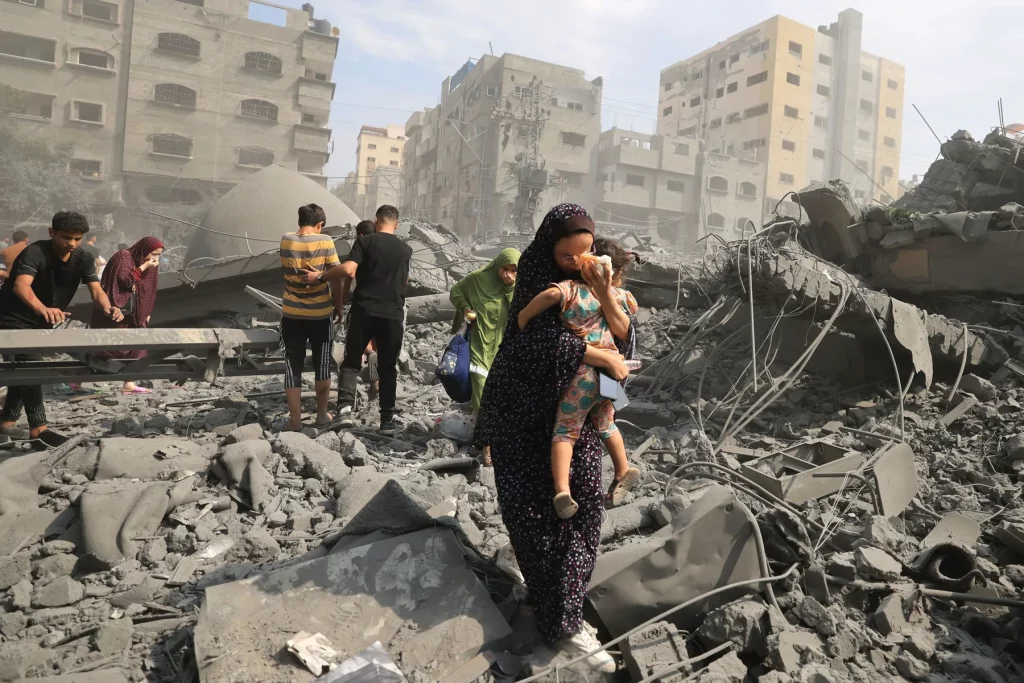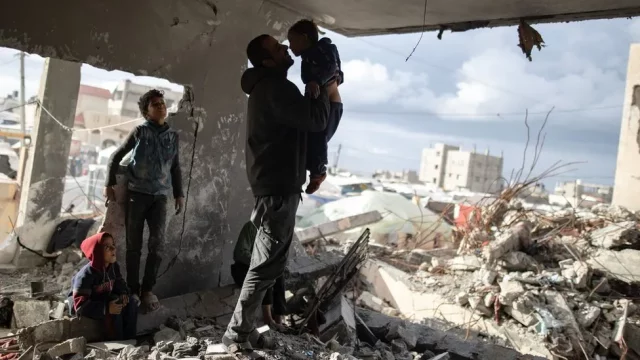This week Al Israa University became the latest major public building in Gaza to disappear from the map, blown up and destroyed by Israeli forces who had reportedly used it as a military base for several weeks.
The war in Gaza has already let to an unprecedented loss of life, but there’s also growing concern about the destruction of public and private buildings.
Now a senior UN official has told BBC News of his fears that the widespread damage will lead to a “lost generation” of young people.
Israel declared war on Hamas after the group led a massive attack on communities inside Israel, killing about 1,200 people – mostly civilians – and taking some 240 others back to Gaza as hostages.
Around 130 remain in captivity. Almost 25,000 Palestinians have since been killed in Gaza, according to the Hamas-run health ministry,
The United Nations’ Office for the Co-ordination of Humanitarian Affairs (Ocha) publishes regular bulletins on the impact of the war, and they make for grim reading.
Its latest updates say that at least 60% of homes or housing units in Gaza have been “destroyed or damaged”. Nine in every 10 schools have suffered “significant damage”. Hospitals, public buildings and electricity networks have also been hit.
Amir Mohammed Al-Najjari is 22 years old. He’s originally from Jabalia in northern Gaza but has been forced with his family to move to a makeshift camp near Khan Younis in the south.

He and his siblings have seen their dreams disappear in clouds of smoke.
“My sister was studying in the third year of Al-Quds University, but it was bombed. And my brother was in his final year of school, at Khalil Al-Rahman school, but it too was bombed,” says Amir sitting outside the makeshift tent the family now calls home.
His own predicament mirrors his brother’s and sister’s.
“I have finished my degree in engineering. If there was no war, I would have a job interview and perhaps I would have been accepted. Finally, there’s my younger brother, who is in the seventh grade. He was studying in the UN school. Nothing is left of it.”
Like any society, Gaza’s future is its children. But here, they’re disproportionately victims of war and, says the UN, may lose out completely on what should be rightfully theirs
Phillippe Lazzarini is the Commissioner General for UNRWA – the UN agency with specific responsibility for Palestinian refugees. He’s just returned from his fourth visit to Gaza since the start of the war.
“There are today more than half a million children in the primary and secondary school system. How will they go back if you cannot bring people back to their homes which have been completely destroyed,” Mr Lazzarini tells me.
“And I’m afraid that we’re running the risk here of losing a generation of children.”
Images of Israeli troops cheering as educational institutions were blown up went viral on social media, including one showing the complete demolition of a distinctive blue UN school in northern Gaza.
Such incidents have led to accusations of “collective punishment” – that Israel is methodically and deliberately destroying institutions including schools in retaliation for what happened when armed Hamas gunmen stormed over the Gaza fence on 7 October.
“Cogat” is the military division that co-ordinates Israeli government activities in the occupied Palestinian territories, including the supervision of aid convoys entering Gaza.
When I asked a senior Cogat official why it was necessary to demolish an entire school after it had already been overrun by Israeli forces, he replied that “Hamas cynically invade and use civilian structures” (like schools) to launch attacks against Israeli troops.
The official also said it was “fact” that Hamas and other armed Palestinian groups were using medical facilities as bases and that in virtually every hospital IDF soldiers had found “terrorist infrastructure”.
Whatever the veracity of those accusations – and they’ve been regularly challenged by health officials and aid agencies – Gaza’s health system is broken.

The World Health Organization says that only 13 of Gaza’s 36 hospitals are functional, many have been damaged in airstrikes. With shortages in basic medical equipment those who need treatment often go without.
Cancer patients and those requiring specialist treatment like kidney dialysis, or neo-natal babies, are especially vulnerable, says the Ocha bulletin.
Nisreen Abu Nimr is also from northern Gaza. She is married, and was a mother to two children, one of whom was killed in a bombing earlier in the war. Nisreen has also been suffering from cancer since 2016.
“I was receiving regular medical treatment for my cancer at a hospital here in Gaza. But, during the Israeli aggression, medical treatments haven’t been provided for four months,” says Nisreen.
Some prominent right-wing Israeli politicians, including members of Prime Minister Benjamin Netanyahu’s government, have suggested the only way to guarantee security for Israel is to “encourage” civilians to leave Gaza for Egypt or other Arab countries and to even re-establish Jewish settlements in the territory.
Israel denies accusations of deliberately turning Gaza into a wasteland, but Mr Lazzarini fears the net impact is that people might have no choice but to leave.
“The facts on the ground are indeed pointing in this direction,” he tells me, clearly anxious that the longer the fighting continues the worse the predicament for more than a million displaced Gazans will become.
“What we have seen is a breakdown in civil order,” adds Mr Lazzarini. “Virtually all infrastructure including water and electricity have been badly damaged, so basic public services in Gaza are not available any more.”
Cogat officials have disputed the scale of Gaza’s humanitarian crisis and they told me Israel does not target civilians or public infrastructure, unless it is suspected of being used by armed Palestinian groups.
They also say they’re working daily in collaboration with UN agencies to get more aid into Gaza.
With other key institutions like Gaza’s parliament and a brand-new courthouse – the Palace of Justice, paid for by Qatar – also destroyed by Israeli forces, there’s very little left of Gazan society.
Israel’s prime minister insists his military campaign in Gaza will continue until “total victory” and Hamas is no longer a threat to Israel.
Official Israeli government policy is that ultimately no Israelis will remain in Gaza, but what will be left of the territory on the day when the war, eventually, ends?







































